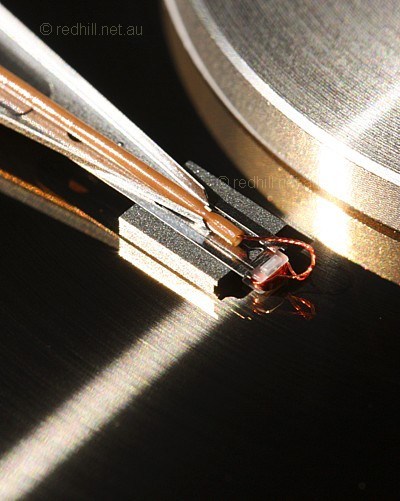
Alps DRR100C91A (105MB, 1992).
Update your bookmark
This is the old site. You probably want the new site.
The new site has all the same information but adds more drives, updated text, and much better pictures of many models.
- Seagate ST-412
- Seagate ST-225
- NEC D5126H
- Seagate ST-251
- Microscience HH-1050
- Tandon TM262
- Miniscribe 3650
- Kyocera KC-20B
- Kalock Octagon KL-230
- Miniscribe 8438 and 8425
- NEC DS3146H new
- Western Digital 93044A
- Seagate ST-157A
- Miniscribe 8051A
- Quantum Prodrive 80AT new
- Seagate ST351A/X
This old version of the Red Hill guide hasn't been updated for about ten years. The new version can be found here.
These are all a long, long time out of production, but they (and others like them) were the drives that made computing for the masses possible. They usually found their way into XT, 286 and early 386 systems. Sometimes we would still see one or another of them in a working machine as late as the end of the century.
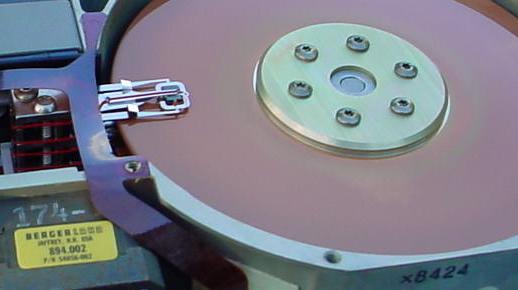
Seagate ST-412
You'll go a long way to find a drive that's older than this one: the ST-412 powered many of the first hard disk-equipped micro computers, notably the original IBM PC-XT.
In 1979 industry veteran Al Shugart, already well-known as the former CEO of floppy drive pioneer Shugart Associates, got together with Finis Conner to co-found a new company, Shugart Technology, which was soon to become Seagate. This was the beginning of storage as we know it. Shugart was responsible for the genesis of the two hard drive interfaces that were to dominate the PC world for decades, SCSI and ST-506/412. In 1980 Shugart produced the world's first 5.25 inch hard drive: the 5MB ST-506. The 10MB ST-412 followed in 1981, and with its selection by IBM for the PC-XT, Seagate was on the way to becoming the world's largest drive manufacturer.
The longevity of some of these old drives is astonishing. We don't know the manufacturing date of the one illustrated above, but in January 2002 we pulled an identical one out of a working machine — that's close to 20 years of service from a device with a design life of no more than five years.
Notice the yellow-labelled black stepper motor at bottom left, and the dull orange of the oxide-coated platters.
If you've grown up using a 286 or a 486 you might have become familiar with BIOS drive types. Back before hard drive auto-detection, the parameters for any particular model of drive had to be hard-coded in the system BIOS. Most 20MB drives were Type 2 or Type 6, nearly all 40MB IDE drives were Type 17, and all more recent drives are user-defined as Type 46 or 47. It is no accident that the ST-412 was Type 1.
| Performance | 0.14 | Reliability | N/A |
| Data rate | 5 Mbit/sec | Spin rate | 3600 RPM |
| Seek time | 85ms | Actuator | Stepper |
| Platter capacity | 5MB | Interface | MFM |
| AT drive type | 1 | Form | 5¼" full-height |
| ST-412 | 10MB | 4 heads | 1981 |
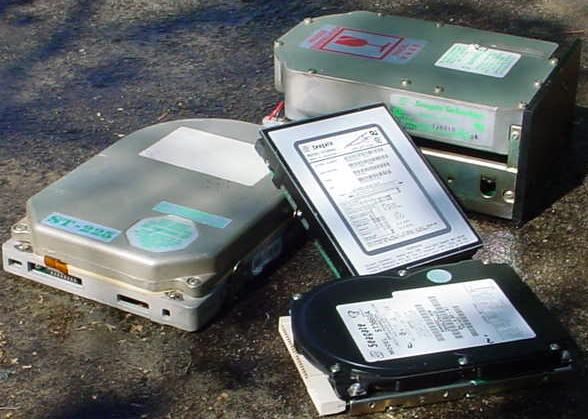
Seagate ST-225
Old reliable. Allowing for market growth over the years, the ST-225 was undoubtedly the best-selling hard drive of all time, as astonishing in its own way as the Z-80 was in its.
The ST-225 was the single most common 20MB drive, and certainly the longest lived. It set the pattern for what would become the traditional, almost the inevitable, entry-level Seagate: a surprisingly low price, ugly styling, modest but reasonable performance, and outstanding reliability.
Incredibly, we would still see ST-225s once in a blue moon right up to the end of the century, fifteen or twenty years old by then, and going just as strong as ever.
The drives illustrated above are four of the Seagate greats. At left, the 20MB ST-225; at top right, the full-height 10MB ST-412, bottom, the ubiquitous Medalist 545; and centre, the tiny 0.75mm high racehorse Decathlon 850. All four would feature high on any list of all-time great hard drives. Together with the even older 5MB ST-506, the ST-412 pioneered the ST-412/506 (MFM) interface. The ST-225 was the drive that (more than any other) made it reliable and affordable.
| Performance | 0.16 | Reliability | AA1 |
| Data rate | 5 Mbit/sec | Spin rate | 3600 RPM |
| Seek time | 65ms | Actuator | Stepper |
| Platter capacity | 10.5MB | Interface | MFM |
| AT drive type | 2 | Form | 5.25" half-height |
| ST-225 | 21.4MB | 4 heads | 1984 |
Tandon (Western Digital) TM262
A very old drive and one of the first to come in the then-new 3.5 inch size. Tandon was a little-known but quite successful drive manufacturer in the early days. Late in the life of the 262 Tandon was bought out by the world leader in hard drive controller cards: Western Digital. WD had the foresight to see that integrating controller cards into the drives themselves was the way of the future, but were unable to find a hard drive manufacturer that was willing to work with them on a joint venture. So in 1988 they simply bought one, Tandon. Some of the last TM-262s had Western Digital badging.
Though the 262s made an unusual, soft sweet seeking sound and were very slow (look at the seek time!) they were usually pretty reliable and a good many of them survived in working order until they were no longer useful — something you could not say about quite a few of the less durable drives of this era.
The 262s show up a weakness in our performance rating system, as they were clearly quite a lot slower than average. We suspect that the problem lies in the measurement of their internal data rate: all MFM drives are regarded as having a 5 Mbit/sec data rate (a limitation of the controller more than the drive) but some were more capable than others of being tuned up by changing the interleave ratio. With a good drive and the right controller you could do a lot with MFM. The details of this are beyond the scope of this part of the hardware guide, but we'll try to find time to add a page about it one of these days. Who knows, with a wet weekend one winter, it might be fun to dive into the boxes of old MFM and RLL gear in the storeroom and do some formal benchmarking.
| Performance | 0.14 | Reliability | AA1 |
| Data rate | 5 Mbit/sec | Spin rate | 3600 RPM |
| Seek time | 85ms | Actuator | Stepper |
| Platter capacity | 10.7MB | Interface | MFM |
| AT drive type | 2 | Form | 3.5" half-height |
| TM-262 | 21.4MB | 4 thin-film heads | 1986? |
NEC D5126H
These were the grand old days for NEC as a hard drive maker. In 1987 when these were selling new, NEC drives were a premium product, suitable for fitting to a top-notch 8 or 10MHz XT clone with an EGA monitor and 640k of RAM, or even a 12MHz 286 rocketship system.
Like the Seagate ST-251H below, the D5126H was a high-performance variant of a slower drive. The H variant was much the more common of the two — the standard 5126 was vastly slower at a glacial 85ms.The drives were beautifully finished in brushed gold alloy, and very heavy. Compare the appearance to other drives of the same era, like an ST-225 or a Miniscribe 3650.
Obviously, the appearance of the outside of a drive has nothing to do with its quality and reliability — or does it?
Over the years we have observed, as a rule of thumb, that there is a distinct correlation between how well drives are finished and how well they perform in the longer term. It is not an infallible rule, of course, but all else being equal if the manufacturer has made the extra effort to make its product look attractive, it will usually have put its best efforts into getting the inside of the product right too. And when a drive maker suddenly starts producing cheap and nasty looking drives — as Maxtor did through the 540MB to 2.1GB era, for example — all too often it is feeling the financial pinch and its quality is dropping too.
| Performance | 0.20 | Reliability | AA2 |
| Data rate | 5 Mbit/sec | Spin rate | 3600 RPM |
| Seek time | 40ms | Actuator | Stepper |
| Platter capacity | 10MB | Interface | MFM |
| AT drive type | 2 | Form | 5.25" half-height |
| D5126H | 21MB | 4 thin-film heads |
Seagate ST-251
Like the notorious Miniscribe 3650 below, these were slow and very noisy, but they tended to keep on going for a good while — unlike some of their high-tech Seagate RLL relatives, which were even worse than the Miniscribe drives.
The ST-251 made a unique hollow knocking noise on start-up, once heard never forgotten, and by far the most distinctive sound of any drive yet made.
There were several versions: the ST-251H was much faster than the standard model (plain ST-251), and then there was the ST-251R, which was a tweaked-up RLL variant on the basic design. The 251R was, not to put too fine a point on things, dreadful; almost certainly the worst drive Seagate ever made and right up there near the top of the all-time dud list with the Kalok Octagon and the Samsung SHD-125. The reliability problems with the ST-251R cast a pall over the entire company for some years afterwards, which was a shame, as the sluggish ST-251 was solid and the 251H excellent. Performance figures are for the ST-251H.
| Performance | 0.23 | Reliability | AA2 |
| Data rate | 5 Mbit/sec | Spin rate | 3600 RPM |
| Seek time | 28ms (or 40) | Actuator | Stepper |
| Platter capacity | 14.3MB | Interface | MFM |
| AT drive type | 40 or 44 | Form | 5.25" half-height |
| ST-251H | 42.8MB | 6 thin-film heads |
Miniscribe 3650
Nobody ever liked these horrible things. They were slow, noisy, unreliable, and ugly. So why were they the world's best selling drive for year after year? At AU$500 each brand new, they were cheap, and they were readily available. You could recognise one of these things blindfolded — the noise they make is unmistakable. This was the drive that took Miniscribe to market leadership — and, when they kept on producing them by the thousand it long after their use-by, took them to bankruptcy as well.
| Performance | 0.17 | Reliability | BA |
| Data rate | 5 Mbit/sec | Spin rate | 3600 RPM |
| Seek time | 61ms | Actuator | Stepper |
| Platter capacity | 13.4MB | Interface | MFM |
| AT drive type | 40 | Form | 5.25" half-height |
| MS-3650 | 40.3MB | 6 thin-film heads |
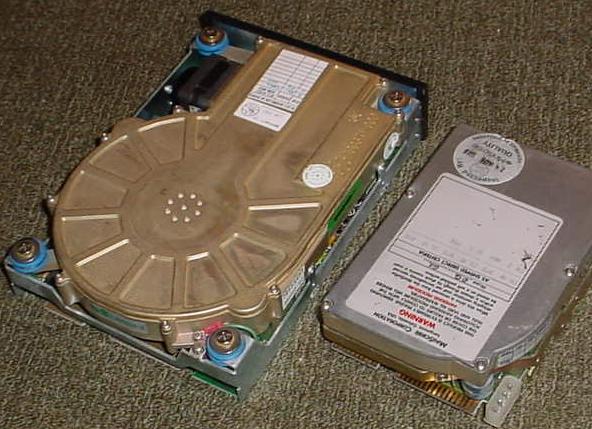
Microscience HH-1050
Microscience were a high-cost, small-volume maker of quality drives — back in the days when you didn't have to be a multinational giant to afford hard drive research and development. They made a range of beautifully crafted 5.25 inch voice-coil drives, all with a distinctive rippled top. The HH-1050 was the smallest and most common of them, and very fast for its day.
Notice the odd number of heads: voice-coil drives need to have positioning information encoded onto the drive itself, so that the heads can find the correct track. (Stepper drives just step in or out the required number of times and hope for the best.) Until the development of embedded servo technology in the early 1990's, all voice-coil drives had to sacrifice one complete surface for head positioning — you can't put data on the servo tracks. This meant that it was uneconomic to make small voice-coil drives — in a single-platter drive, you'd waste 50%, but in a big 8-platter drive, you only waste 12.5%. Notice that a few new drives still did this until about 1995.
Picture: Two MFM drives. The 5.25 inch Microscience HH-825 on the left was high-end class, almost equivalent to a Cheetah X15 today. The little 20MB Miniscribe 8425 was an early 3.5 inch stepper drive, still mass-market but a cut above the big old 3650s and ST-225s. This one was manufactured on 24th August 1989. The Microscience goes back to June 1987.
| Performance | 0.29 | Reliability | AA1 |
| Data rate | 7.5 Mbit/sec | Spin rate | 3600 RPM |
| Seek time | 28ms | Actuator | Voice coil |
| Platter capacity | 16.8MB | Interface | RLL |
| AT drive type | 2 | Form | 3.5" half-height |
| HH-1050 | 42MB | 5 thin-film heads | 1987 |
Kyocera KC-20B
Another memorable little drive from a company that has long since exited the business. These days, Kyocera are a major manufacturer of laser printers, but it's a long, long time since they made a hard drive. Still, at least with this particular model Kyocera were obviously successful as a drive manufacturer: KC-20s were quite common in their day and remained around as valuable trade-ins well into the early Nineties.
Like so many early drives, you could recognise the KC-20 by sound alone — something you almost never get with modern drives. The sweet little high-pitched pinging noise the Kyocera's seek mechanism made was unique. In practical terms, the drives themselves were nothing out of the ordinary: reasonably reliable as MFM drives went, a little on the sluggish side, not very different to a half-dozen others of the same vintage.
| Performance | 0.16 | Reliability | AA2 |
| Data rate | 5 Mbit/sec | Spin rate | 3600 RPM |
| Seek time | 65ms | Actuator | Stepper |
| Platter capacity | 10.5MB | Interface | MFM |
| AT drive type | 2 or 6 | Form | 3.5" half-height |
| KC-20B | 21MB | 4 thin-film heads |
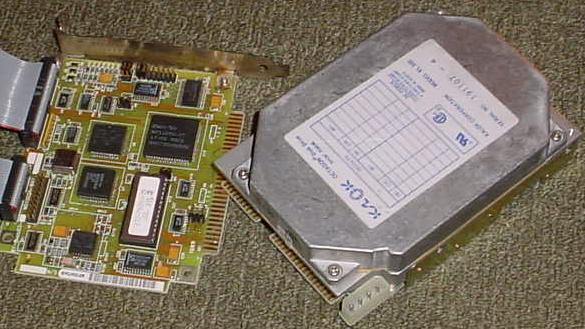
Kalok Octagon KL-230
Kalok was founded by a former Seagate engineer, the same man who had been largely responsible for the ST-225. The company seemed to live on the edge of bankruptcy most of the time, and later morphed into JTS. Like all Kalok drives, the KL-230s had a dreadful reputation but we always found this model pretty good. We never saw new ones, only second-hand, so maybe all the duds had already expired by then.
Picture: A Kalok Octagon 330 — essentially an RLL certified 230 — with Western Digital 1002A-WX1 MFM XT controller. Western Digital had missed out on the biggie — the IBM contract for the XT, but they soon established themselves as the controller manufacturer of choice.
| Performance | 0.19 | Reliability | AA2 |
| Data rate | 5 Mbit/sec | Spin rate | 3600 RPM |
| Seek time | 48ms | Actuator | Stepper |
| Platter capacity | 10.5MB | Interface | MFM |
| AT drive type | 2 or 6 | Form | 3.5" half-height |
| KL-230 | 21MB | 4 thin-film heads | |
| KL-330 | 30MB | 4 thin-film heads |
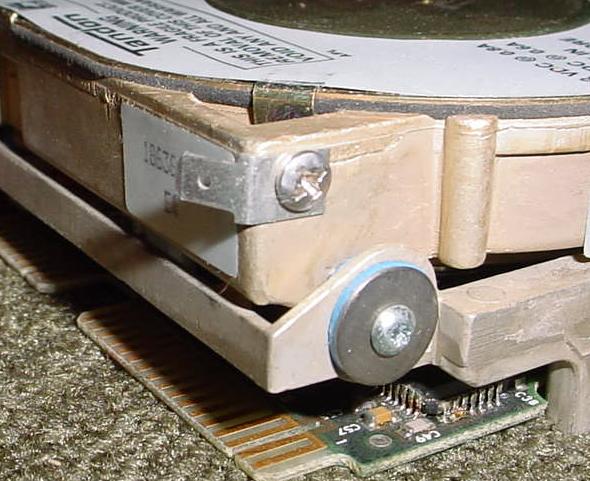
MFM and RLL
Most hard drives of the pre-IDE period used MFM (Modified Frequency Modulation) encoding. Floppy drives still do. MFM was not the only twin-cable hard drive interface though: aside from its close relative RLL, there was also the now long forgotten high-end competitor to SCSI, EDSI.
MFM was relatively simple to implement, and quite robust. RLL (Run Length Limited) encoding used the same electrical interface and cables but a different data format (much as Morse Code and Baudot code are different). An RLL format squeezes the information more tightly onto the disc and increases the effective areal density by 50%.
So a 10MB MFM drive, if formatted with an RLL controller, could now store 15MB, and can be up to 50% faster too. Almost all MFM drives had 17 sectors per track, but RLL drives squeezed 26, or even 32 sectors onto each track. RLL did, however, require a very accurate drive mechanism.
Early attempts to increase speed and storage capacity by adding an after-market RLL controller to an MFM drive system often resulted in poor reliability. This gave RLL an undeserved bad name. Later on, many drive manufacturers introduced RLL certified models, and these were generally just as reliable as their cheaper, smaller MFM drives. (See Miniscribe 8438 below.)
Technically, there was no such thing as an 'RLL drive'. The drive type (MFM or RLL) was solely determined by the low-level format, and this in turn, depended on the drive controller card. In theory, any ST-506 (two-cable) drive could be formatted with either an MFM or an RLL controller. Not many early drives, however, were capable of taking an RLL format reliably.
All modern drives use an embedded controller (usually IDE or SCSI), which is built into the drive itself. The card we used to call a 'controller card' and plug into IDE-equipped 386 systems was actually just an interface between the drive controller proper (on the actual drive) and the PC bus. It should really have been called a 'host adaptor'. (Since late 486 days, this is integrated into the motherboard and it is unusual to have an IDE host adaptor as a separate, plug-in component.) Until the advent of PRML in the mid-1990's, all IDE and SCSI drives actually used RLL encoding internally. IDE and SCSI drive electronics are 'smart' enough to take care of encoding in such a way that we no longer need to know the details.
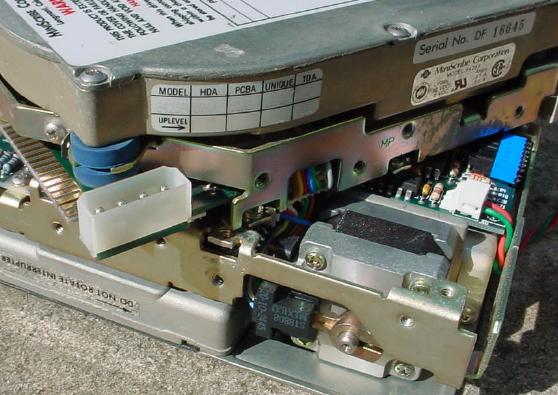
Miniscribe 8438 and 8425
An interesting pair of drives, identical except for the badge. Miniscribe was Seagate's biggest competitor for the mass market during the late Eighties and the 8425/8438 twins were a major part of Miniscribe's quest for overall market leadership. They sold in vast numbers.
→ A pair of the new-style three and a half inch drives that were making Seagate's ST-225s look very dated. On top, an immaculate late-model 8425 which left Miniscribe's Singapore production line on 15th August 1989. Underneath, an 8438 dated 28th March 1988. Almost fifteen years later, both still work perfectly. Notice the 8438's large black and silver stepper motor at lower right.
The 8438 was a neat, modern looking 3.5 inch 30MB stepper drive with factory-certified RLL capacity. The 8425 was the exact same drive without the certification. In other words, Miniscribe produced these drives and then tested them. The very best ones were sold as 8438s, the also-rans as 8425s. Of course, there was nothing to stop you buying a 20MB 8425 and putting it with an RLL controller to get 30MB — except that it was unlikely to work properly for very long.
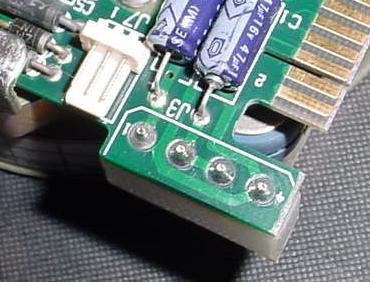
We used to do the reverse sometimes: buy an 8438 and put it on an MFM controller to make an almost bullet-proof 20MB drive system. It was fairly expensive, but ideal for reliability-critical jobs. Since the 8438 was RLL certified, we already knew it was a particularly good drive, and by running it on an MFM controller we had a huge margin of safety. I can't remember ever seeing one of these under-stressed 8438s fail. Though we still saw ST-225s from time to time up until the end of the century, we haven't met either one of the 8438/8425 twins in a working system for many years now.
By the way, these were one of the earlier 3½ inch drives to become common. Notice that the modest-looking capacity per platter is actually quite high when you consider that the discs are much smaller than was common at the time.
→ The 8425's absurdly flimsy power connector design. Standard nylon power plugs varied in size even more in those days than they do today, and getting a tight-fitting power cable out of an 8425 without breaking the PCB was often very difficult. The small white three-pin connector just above and to the left of it, by the way, is for a drive activity LED, and the light blue washer semi-visible through the gap between the power socket and the data cable edge connector is a shock mounting for the HDA. You get a better view of it in the picture above.
| Performance | 0.16 or 0.20 | Reliability | AA2 |
| Data rate | 5 or 7.5 Mbit/sec | Spin rate | 3600 RPM |
| Seek time | 65ms | Actuator | Stepper |
| Platter capacity | 10.7MB or 16.45MB | Heads | 4 thin-film |
| AT drive type | 2 | Form | 3.5" half-height |
| MS-8425 | 21.4MB | 5 Mbit/sec | MFM |
| MS-8438 | 32.7MB | 7.5 Mbit/sec | RLL |
NEC DS3146H
A fairly rare drive, but one of the very best pre-IDE drives around. The 3146 was fast and very reliable. It was the last ST-506 (pre-IDE) drive we ever sold, and was every bit as good as the three early IDE steppers below. NEC kept on making nice hard drives, by the way, for a good long while after this, though eventually they shifted to just manufacturing under license from IBM before giving it up altogether.
| Performance | 0.21 | Reliability | AA1 |
| Data rate | 5 Mbit/sec | Spin rate | 3600 RPM |
| Seek time | 35ms | Actuator | Stepper |
| Platter capacity | 10.5MB | Interface | MFM |
| AT drive type | 2 | Form | 3.5" half-height |
| TM-262 | 40.3MB | 8 thin-film heads |
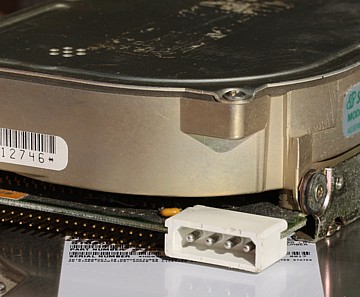
Seagate ST-157A
The best of the IDE steppers, very reliable, and almost as fast as the Maxtor/Miniscribe one. These are instantly recognisable by their half-circle shape. Seagate were very late entrants into the 3.5 inch drive market, having been distracted by their quality problems with the ST-251R, rapidly falling market share when the clone makers began to take over from IBM, and their acquisition of mainframe drive maker Imprimis, but when they finally released 3.5 inch drives they were good ones. Most ST-157s were still going just fine when they were finally retired in favour of something much bigger and newer.
| Performance | 0.29 | Reliability | AA1 |
| Data rate | 7.5 Mbit/sec | Spin rate | 3600 RPM |
| Seek time | 28ms | Actuator | Stepper |
| Platter capacity | 14.8MB | Interface | IDE mode 0 |
| AT drive type | 2 | Form | 3.5" half-height |
| ST-157A | 44.4MB | 6 thin-film heads |
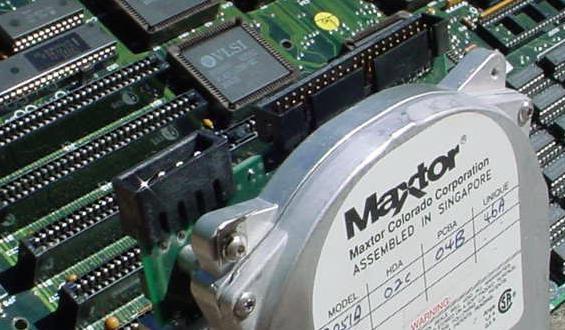
Miniscribe (Maxtor) 8051A
The fastest of the IDE steppers, very racy looking in the flesh, and a good drive.
This was Miniscribe's last gasp, their last attempt to deliver modern, reliable product before they went broke and Maxtor took them over. And it was successful — it didn't save the company, but it was just about the only Miniscribe drive to resurface with the Maxtor name. As for the rest of the Miniscribe product line — Maxtor junked it.
Lee of Manassas, Virginia sent us an interesting note about the 8051A:
I got my hands on one of these drives, and while it may sound like a stepper, it's not — I opened it, and it uses a rather odd actuator, sort of the converse of a rotary voice coil (it works the same way, only the coil is stationary and the magnet moves). I'm fairly sure this drive uses embedded-sector servo. By the way, compare the squeal it makes on startup to the one the Maxtor 7120 (and possibly the 7040 or 7080) makes. They're pretty close, and apparently, so is the hardware. It would seem this drive was pretty much ancestral to the entire 7000 series, and by extension the DiamondMaxes of today (which, if you check the labels, still have the old Miniscribe-style HDA/FIRMWARE/UNIQUE/UPLEVEL and date code stamps on them). MiniScribe may no longer exist as such, but their legacy, such as it is, is definitely still with us.
| Performance | 0.30 | Reliability | AA2 |
| Data rate | 8 Mbit/sec | Spin rate | 3484 RPM |
| Seek time | 28ms | Actuator | Stepper |
| Platter capacity | 21.3MB | Interface | IDE mode 0 |
| AT drive type | 2 | Form | 3.5" half-height |
| MS-8051A | 42.7MB | 4 thin-film heads | 1986? |
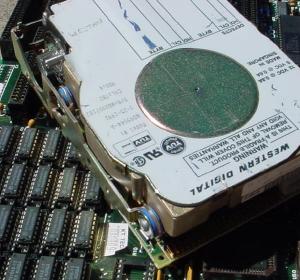
Western Digital 93044A and 95044A
These, unfortunately, sold in their thousands. They were a half-way house between the old and very slow but quite reliable Western Digital/Tandon 20MB 70ms MFM drives, and the excellent Western Digital Caviar voice coil drives that came out not too long after. They usually made an unmistakable and very odd hissing sound, especially when they were on the verge of failing, which was quite often.
The 95044A was identical but for a factory-fitted 5.25" mounting bracket. Notice the black stepper motor at the top left corner. Stepper drives were about to disappear forever, and these were their not particularly grand finale.
A smaller brother to this pair with an eight-bit IDE interface was almost single-handedly responsible for Amstrad's dreadful reputation for unreliability, and resulted in a long and bitter legal action between WD and Amstrad. Not, of course, that Amstrad needed any help on the reputation front — they were entirely capable of making their own bad reputation.
Illustration: the pictured drive is actually a 95044A with the bracket removed. It's a very ugly picture, but then that seems appropriate — these were a very ugly drive.
| Performance | 0.29 | Reliability | BA |
| Data rate | 7.8 Mbit/sec | Spin rate | 3329 RPM |
| Seek time | 28ms | Actuator | Stepper |
| Platter capacity | 21.6MB | Interface | IDE mode 0 |
| AT drive type | 17 | Form | 3.5" half-height |
| 93044A/95044A | 43.2MB | 4 thin-film heads |
Seagate ST351A/X
The last 40MB drive made, and one of the better ones. It was an odd mix of technologies: high areal density — only one disc — but an old-fashioned stepper motor. Presumably, this relatively high-speed but low cost combination was why Seagate were able to keep them in production well after all the other 40s were uneconomic. This drive was unique in that it was jumper-setable for eight-bit or sixteen-bit IDE — so you could use it in an XT. Quite fast in its day and and reasonably reliable, but ridiculously difficult to strap up for master/slaving, and if you strapped them the wrong way you blew them up!
The best 40MB drives of all were the more expensive voice-coil Western Digital Caviar and the beautiful little black IBM. The various Conner 40s were a mixed bag.
| Performance | 0.37 | Reliability | AA2 |
| Data rate | 14 Mbit/sec | Spin rate | 3048 RPM |
| Seek time | 28ms | Actuator | Stepper |
| Platter capacity | 42.8MB | Interface | IDE mode 0 |
| AT drive type | 17 | Form | 3.5" third-height |
| ST-351A/X | 42.8MB | 2 thin-film heads |
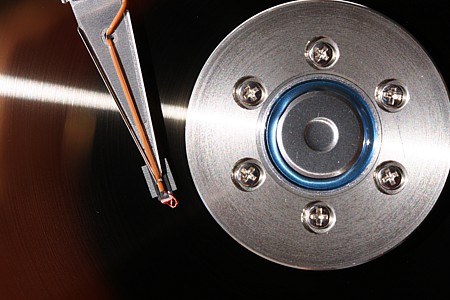
Alps Electric DRR-40
A very odd little drive. Alps Electric haven't made hard drives for many years, though they continued manufacturing floppy drives for a long time, and laptop touchpad pointing devices for years after that, but these little 40MB units were always good performers. They were very small and thin, especially by the standards of the day, and used an odd-ball small power connector like a 3.5 inch floppy drive. As usual with early IDE drives, they didn't master/slave well. There were identical-looking Alps 105 and 200MB drives too.
The Alps drives were some of the first ones to use sector translation to get more than 1024 tracks on a disc. This used to cause troubles with the IDE 'identify' command, which was employed by auto-detect BIOS or drive utility programs to ask the drive what its correct parameters were (heads, cylinders and sectors per track). The Alps 40 returned its actual parameters, where more recent drives returned their logical parameters. So, if you auto-detected an Alps 40 using a standard pre-LBA BIOS, you had to halve the cylinder count and double either the heads or the sectors per track. (Or, for that matter, use any other three CHS figures that added up to the correct size and didn't violate the CHS maxima: 1024 cylinders, 16 heads, 63 SPT.) It's been some years since we've seen one of these.
| Estimated performance | 0.45 | Reliability | AA2 |
| Estimated data rate | 15 Mbit/sec | Spin rate | 3600 RPM |
| Seek time | 19ms | Actuator | Voice coil |
| Platter capacity | 10.7MB | Interface | IDE mode 0 |
| AT drive type | 17 | Form | 3.5" quarter-height |
| DRR-40 | 42MB | 2 thin-film heads |


